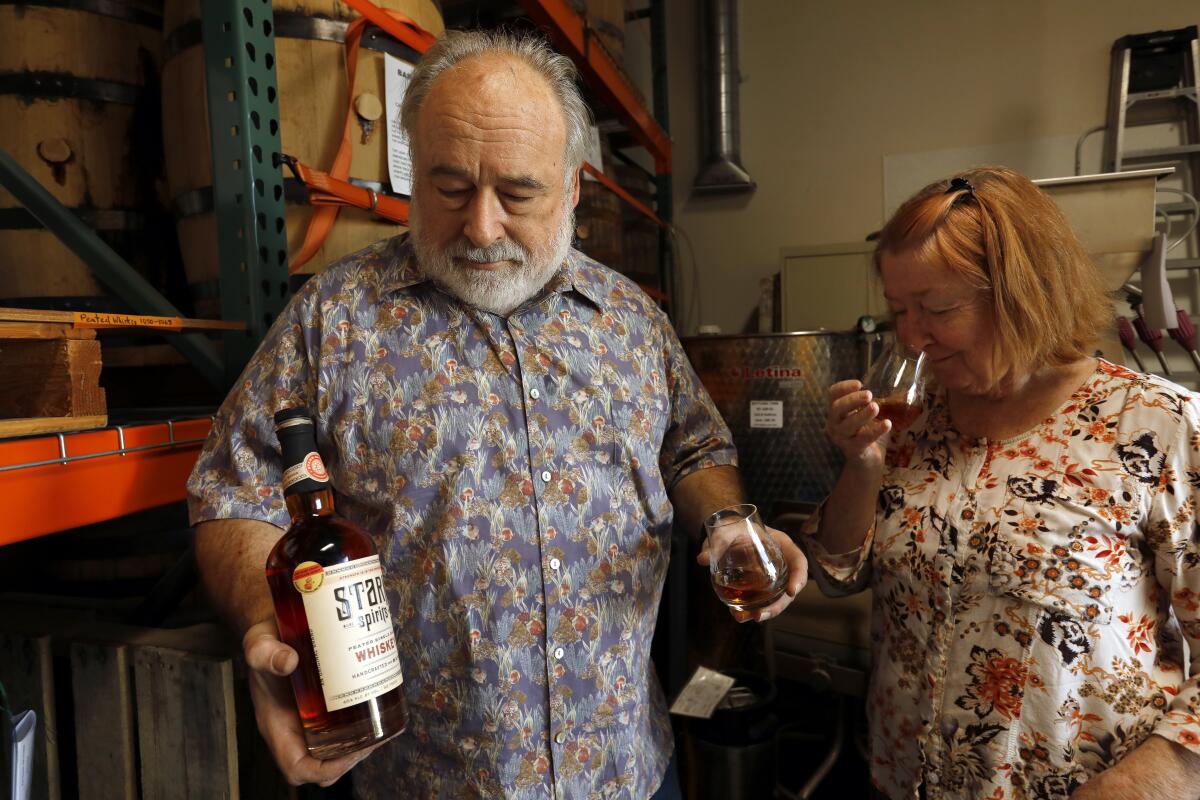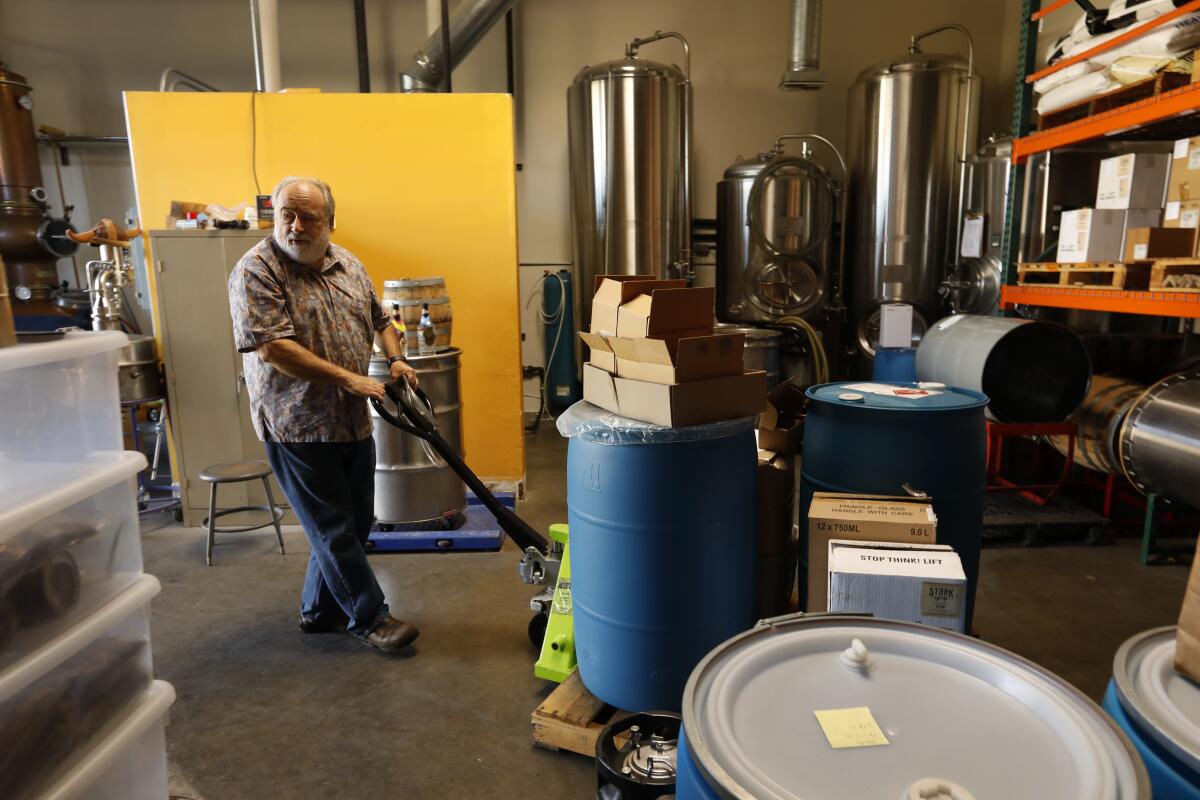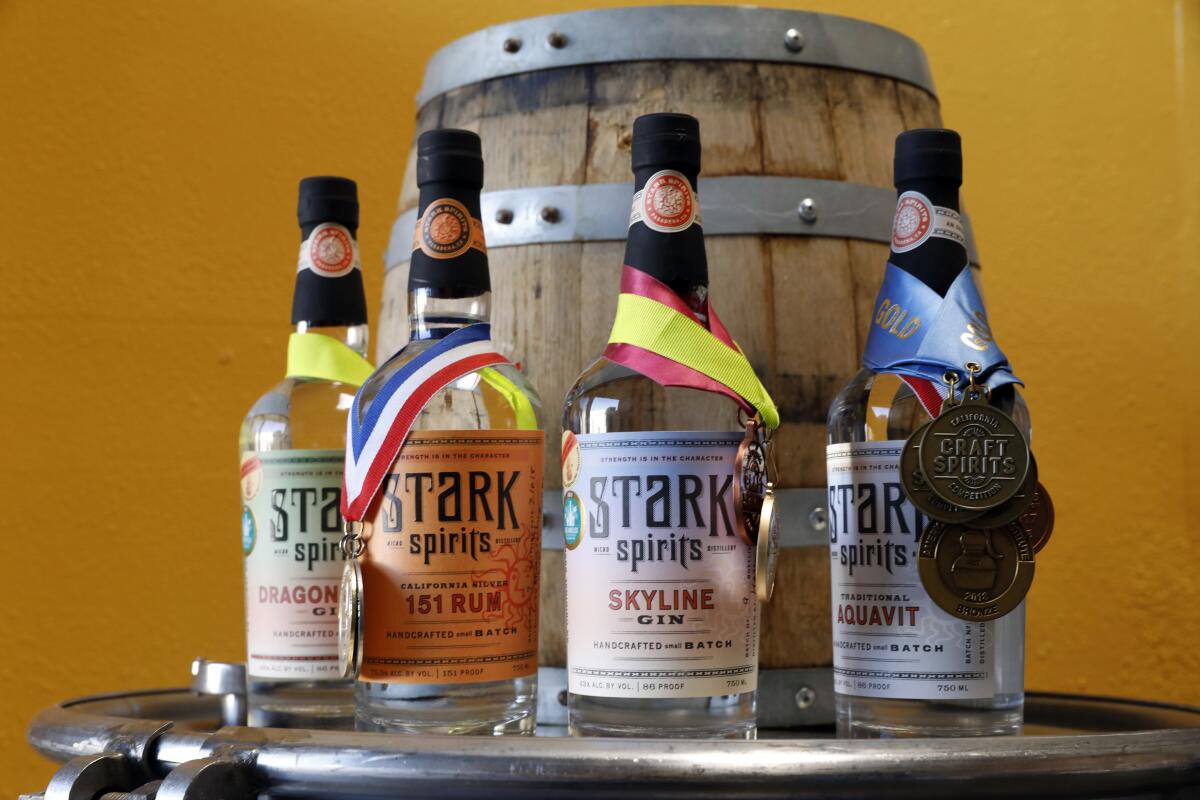California craft distillers’ spirits lifted for now with relaxed regulations

- Share via
Karen Robinson-Stark and her husband, Greg Stark, are old-timers in California’s craft spirits industry. They built their Pasadena distillery in 2013, the dawn of the modern craft movement, and anticipated that Stark Spirits might turn a profit this year.
But the pandemic changed that dream, as it did for so many people in food, liquor and hospitality businesses.
“The capital and labor investment to build a craft distillery is huge,” says Karen Robinson-Stark. Skimpy margins mean restaurant waiters and bartenders are front-line marketers explaining the value of paying extra for the unusual. Purveyors of craft spirits like the Starks are often too small to attract a distributor; they rely on tasting-room sales, limited by the state to just three bottles per visitor.
When things shut down in March, demand for alcoholic beverages shot up, but California’s small distillers frequently couldn’t get their products where they needed to be. Sales collapsed.
It looked likely the Starks and other small distillers would lose their businesses, wiping out years of sweat equity.
No one understood the craft distiller’s plight better than Jacob Appelsmith, the now-retired director of California’s Department of Alcoholic Beverage Control and, for years, the enforcer of the copious and confusing rules governing the production and sale of alcohol in the state.
He helped craft distillers to keep their heads above water.

During his two stints heading the state’s ABC (early 2011 to mid-2013; mid-2017 to July), Appelsmith helped draft and then execute California’s Craft Spirits Act of 2015, igniting a renaissance in micro-distilling. In two years, the number of small distilleries in California quadrupled. Today, the state boasts 138 craft distilleries licensed under the act, giving California more distilleries than any other state.
“Craft distilling can be a huge thing for California, as big as craft beer, if they do it right,” says Appelsmith, now an attorney at Pillsbury in Sacramento. “They need to form a cohesive community, like the brewers did.”
But with most new distillers years from profitability, Appelsmith knew many would not survive the COVID era. He called Cris Steller, owner of Amador & Dry Diggings Distillery and executive director of the California Artisanal Distillers Guild, and offered to bend some rules.
“We looked for ways to help the distillers by suspending enforcement of our rules,” Appelsmith says.
The offer “was unexpected,” Steller says.
The distillers had a wish list of relief already in hand, a 30-year plan they hoped would put spirits on par with wine and beer, although they thought the last item — direct sales to consumers and third-party shipping — was magical thinking.
In March, Appelsmith says, the ABC pushed hard to allow stills to be repurposed to make much-needed hand sanitizer, giving distillers a new product they could sell quickly. During the early spring, “Sanitizer kept us alive, kept a lot of places alive,” Greg Stark says.
What happens when you try to make your hand sanitizer with stuff you got from BevMo to ward off the coronavirus? Just wash your hands instead.
“It was a delicate time,” Appelsmith says. The goal was to allow all ABC licensees — restaurants, bars, stores, distilleries, wineries and breweries — to safely engage with their customers as much as possible.
One allowance granted by the ABC was to streamline the approval process for turning distillery tasting rooms into restaurants. As long as they served a proper meal, craft distillers could sell cocktails.
Some requests crossed the line, says ABC general counsel Matthew Botting. “The craziest one was to sell to people under 21 years old. What part of that made sense?”
And cocktails-to-go looked dodgy, he adds. He was surprised it worked without inspiring a crush of drunken street parties.
The craft distillers’ 30-year regulatory relief effort telescoped down to three months when, in June, craft distillers, within California, were allowed to sell direct to the public with third-party delivery.
“We had no hesitation on any of this,” Appelsmith says. “If there were issues, we could always dial it back. But there were none.”
“The question is, after COVID, will they pull back the relief or help us make it permanent?” asks Ryan Friesen, head distiller at Santa Ana’s Blinking Owl.
That answer is likely to define the future of craft distilling in California.
“Historically, distilled spirits were always treated differently because, at 40% alcohol, they are consumed differently than wine or beer,” Botting says. It is up to state legislators to change that paradigm.
The new regulatory approach has made up for lost tasting-room sales, says Andrew Caspary, a founder of Ventura Spirits. If it sticks, he will still depend on his tasting room and restaurants to win new customers. But he’ll be able to reach those customers more easily, and his sales, he hopes, can grow more quickly.
Similar regulatory relief stories are playing out with craft distilleries and state ABCs across the country, says Rebecca Harris, cofounder of rural Virginia’s Catoctin Creek Distilling Co. and head of the American Craft Spirits Assn.
“We are the alcoholic drinks sector with the tightest controls, the most difficult place to make money,” says Harris, noting that the United States has 2,000-plus craft distilleries.
A California craft distiller is allowed to distill or produce only 150,000 gallons of spirits a year. The Starks, like many, have yet to sell 1,000 cases in total, roughly 5,000 gallons.
Some distillers spend less than $500,000 to launch, not counting the long, hard years of unpaid labor on their passion projects. More commonly, folks spend $1 million to $2 million and reach profitability in four or so years.
White spirits (gin and vodka) are quick money and keep the lights on. Brown spirits (bourbons, ryes, brandies) are more profitable but require aging. Three years of aging is a luxury, Friesen says. “The effort and funds to do that are incredible.”

What distinguishes craft distillers is their creative imprint on their spirits. Unlike the less expensive big brands, they typically try to make their booze idiosyncratic.
Downtown L.A.’s Spirit Guild distills fruit from owner Miller Duvall’s Bakersfield clementine groves. Ventura Spirits forages botanicals for its Wilder Gin from the Southern California’s coastal mountains.
Blinking Owl stresses its “soil-to-glass” spirits made in-house with only organic California wheat, rye, barley and corn. “We think Santa Ana’s clean, naturally filtered aquifer water is a big piece of the puzzle,” Friesen says.
The secret behind Stark Spirits? Karen Robinson-Stark, a former college teacher, and her software engineer husband ignore what’s expected and geek out making spirits that taste great to them.
More to Read
Eat your way across L.A.
Get our weekly Tasting Notes newsletter for reviews, news and more.
You may occasionally receive promotional content from the Los Angeles Times.











